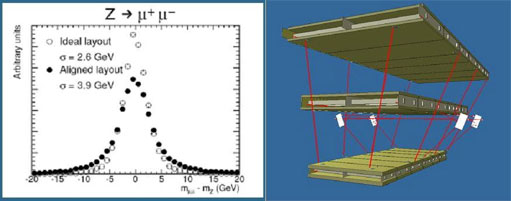
ATLAS e-News
23 February 2011
Calibrating and Aligning the ATLAS Detector
27 May 2008

The left plot shows the distribution of the reconstructed mass of simulated Z bosons decaying into two muons, assuming either that the ID geometry is perfectly known (open circles) or after the alignment procedure based on one million tracks and about 20000 cosmic events (full circles). The right figure shows a layout of the optical alignment system for a sector of the muon spectrometer.
The calibration and the alignment of the many ATLAS sub-detectors is certainly one of the most challenging tasks that we will have to face when the first data are available.
One can distinguish several types of calibration and alignment tasks. In a first category, we can consider the following online electronic calibrations:
- The electronic calibration tasks performed online at the level of the Read-Out-Drivers during the periods without beam either in between two consecutive LHC spills (less than an hour) or during LHC machine downtime. Examples of such tasks are pedestal, ramp or charge injection runs to determine the calorimeter cells response or the threshold scans in the pixel detectors to look for dead and noisy channels
- The electronic calibration tasks performed during the normal physics data taking with beam, which take advantage of the presence of so-called empty bunch crossing. Actually, during the normal data taking mode with a 25 ns time lapse between two consecutive bunch crossings, more than 20% of the crossings involve empty bunches, reflecting the complex multi-stage injection scheme of the LHC involving the PS and the SPS machines. Only a very small fraction of these empty bunch crossings will be used for checking the behaviour of the tile calorimeter during physics runs by injecting known charge or laser shots. These empty bunch crossings will also be used for acquiring cosmic data for the Inner Detector (ID) alignment as discussed later.
- The optical alignment of the SCT and the muon spectrometer which will run totally asynchronously with the data taking flow. Both systems will provide new sets of alignment constants every half an hour or so, in order to track with a few microns precision possible movements of the tracking elements they are monitoring: barrel layers and end cap wheels for the SCT alignment system, individual muon chamber displacements and deformations for the muon alignment.
In a second category, we find the offline calibration and alignment tasks based on specific calibration events taken during the physics runs. They are processed right after the data taking in order to upload the new updated calibration constants in the ATLAS condition Data Base before the start of the reconstruction of the bulk of the physics data 24 to 48 hours later. According to the type of calibration events, we can distinguish:
- The calibration and alignment tasks relying on a specific calibration stream containing events with a topology well suited for this calibration or alignment. A first example is provided by the ID alignment stream which aims at collecting daily about one million of events containing isolated pions. The ID alignment requires also another stream collecting cosmic events with a few Hz rate taken during empty bunch crossings. The impact of the alignment procedure on the width of the reconstructed Z boson mass peak is shown on the figure. Although the mass peak would be totally washed out without alignment, more work is needed to control the remaining geometry distortion still not seen by the alignment algorithm. The calibration of the muon spectrometer MDT drift tubes, aiming at the determination of the relation between the drift radius and the drift time, will be based on a large statistics calibration stream selecting and collecting muon tracks at the second level of the trigger chain. In contrast to the other streams, the muon calibration stream will be transferred and processed at three external so-called Tier2 centres (Michigan, Munich, Rome), the new calibration constant being shipped back to CERN before the bulk reconstruction.
- The calibration and alignment tasks based on the express stream. This stream contains about 10% of the physics data, duplicated from the normal physics streams, which are of particular interest for monitoring the quality of the data after the offline reconstruction. In particular, it contains most Z bosons decaying in the di-lepton channel, a fraction of the leptonic W decays and events with very high transverse or missing energy. These latter events may spot noisy channels or dead modules. Some sub-systems will take advantage of the fast processing of the express stream (start less than an hour after the data taking) to use it for calibration or alignment purpose, like for instance the relative alignment of the muon spectrometer with respect to the ID.
The various sub-systems are working very hard to implement the trigger and software chains which will enable an as smooth as possible processing of these rather complex procedures. A significant fraction of them will hopefully be tested early June 2008 during a system test of the offline part of the data processing, called “Full Dress Rehearsal” (FDR). In the FDR the data produced at the output of the acquisition system are mimicked by simulated events from different physics channels mixed in such a way that they reproduce as much as possible the physics data content expected during the first months of LHC data taking.
Soon after the FDR, the first real data will show up, hopefully during summer, with their attendant surprises, excitements and possibly hobbling detector behaviour, and we should make sure that this whole edifice is robust enough to provide within a short time scale sensible data for physics analysis.

|